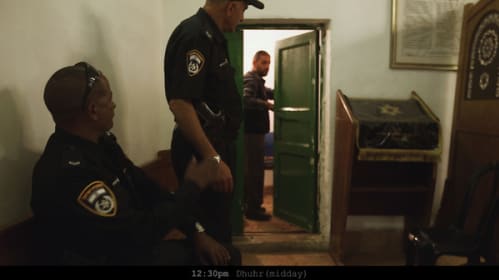Nira Pereg Ishmael, 2014/2015 Three channel video installation 00:11:03 min Cave of the Patriarch/Abraham’s Mosque, Hebron, West Bank Ishmael documents a day in the life of a Muslim Muazzin at the Cave of the Patriarch in Hebron. Located in Hebron, at the heart of the west bank, the Cave of the Patriarch is sacred for both Jews and Muslims. After the Goldstien massacre in 1994 the cave was divided with 80% serving as a mosque, and 20% as a synagogue. Soldiers from he Israeli Defense Forces (IDF) control the doorway connecting the two separate areas. The Islamic call to worship (adhān) is recited by a Muezzin five times a day. Due to the particular architectural division between Muslims and Jews in the Cave of the Patriarch, the room from which the Muezzin calls from was left in the Jewish side of the cave. Ishmael follows the journey of a Muezzin, escorted by IDF soldiers, as he makes his way from the mosque through the synagogue and back. The film highlights the performative qualities of this routine. These qualities touch upon the links between rituals and territory, which are exacerbated by this particular merging of time and place. Filming and projecting each cycle in an identical manner exposes their singularity. Multi-channel screening makes this single day routing into a chaotic union of time and place. Ishmael continues Pereg’s ongoing interest in the Cave of the Patriarch, as a major locus for events that shed light on the complex intertwining of belief systems, social rituals and politics. This location also features in her videos Abraham Abraham and Sarah Sarah(2012). Shot under IDF supervision, the films document a process that is never shown publicly. The exhibition The video opens by the dividing door of the mosque, where the Muezzin awaits the IDF soldiers who will escort him through the Jewish section up to the green door of the room from where the adhān is recited. Once in, the Muezzin locks the door while the soldiers guard it. When the prayer is over the Muezzin is escorted back to the mosque area. Due to the demand Jewish prayers, the sunset Muslim adhān is not recited in this manner and instead a Jewish Hazan calls for the evening prayer (Mincha) This arrangement is just one of the surreal routines maintaining the fragile status-quo in the cave over the last two decades. As viewers move about the film installation, they can stand in the middle of the space where all the voices can be heard as harmonious music, or by each screen where events can be observed separately. Pereg has created a limited edition sun clock that, with the Cave's symbolic and functional dividing wall as its dial.

